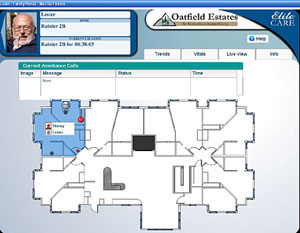
With 79 million baby boomers getting older, there will not be enough labor to care for the elderly in their homes. This profile describes how one assisted living provider, Oatfield Estates, is using technology to improve care, quality of life, and productivity.
Though using technology to help care for older people may sound cold and machinelike, they thought it would help humanize care.
For instance, while many facilities for people
with Alzheimer's have locked doors, Oatfield uses sensors to determine
when people wander off the 6-acre campus, so doors don't have to be
locked.
The technology also can help track the health of
residents less intrusively than humans do. Sensors track how social a
resident is, how often he goes out, how much time he spends alone, how
much weight he has gained or lost, or how restless he is. Families and
staff can use that information to notice possible problems, such as a
resident spending more time sleeping or getting up at night more often.
Many of these same tracking technologies, like Living Independently, can be installed in private homes - of course without the on-site staff. Both ADT and Philips are also moving into the remote monitoring market. (More here, here and here.)
As an aside, elder care is one of the three initial target markets for Continua Health Alliance.
With 79 million baby boomers getting older, there will not be enough labor to care for the elderly in their homes. This profile describes how one assisted living provider, Oatfield Estates, is using technology to improve care, quality of life, and productivity.
Though using technology to help care for older people may sound cold and machinelike, they thought it would help humanize care.
For instance, while many facilities for people
with Alzheimer's have locked doors, Oatfield uses sensors to determine
when people wander off the 6-acre campus, so doors don't have to be
locked.
The technology also can help track the health of
residents less intrusively than humans do. Sensors track how social a
resident is, how often he goes out, how much time he spends alone, how
much weight he has gained or lost, or how restless he is. Families and
staff can use that information to notice possible problems, such as a
resident spending more time sleeping or getting up at night more often.
Many of these same tracking technologies, like Living Independently, can be installed in private homes - of course without the on-site staff. Both ADT and Philips are also moving into the remote monitoring market. (More here, here and here.)
As an aside, elder care is one of the three initial target markets for Continua Health Alliance.
Pictured right is an example of what a family member might see concerning their loved one residing at Oatfield Estates.


Recent Comments